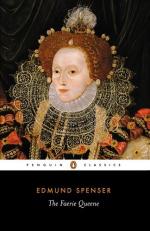317. AN ALTARE, cf. Revelation, vi, 9. CARV’D WITH CUNNING YMAGERY, “in allusion to the stimulus given to the fine arts by the Church of Rome” (Percival).
366. BRAWNED BOWRS, brawny muscles.
375. WHAT EVILL STARRE, etc. In Spenser’s day, belief in astrology, the pseudo-science of the influence of the stars on human lives, was still common.
381. There was an old familiar ballad entitled Fortune my Foe.
384. i.e. your good fortune will be threefold as great as your evil fortune.
384. GOOD GROWES OF EVILS PRIEFE, good springs out of our endurance of the tests and experience of evil.
391. BEST MUSICKE BREEDS DELIGHT, etc. A troublesome passage. Upton and Jortin emend delight to dislike; Church inserts no before delight and omits best; Kitchin suggests despight; Grosart prefers the text as it stands with the meaning that although the best music pleases the troubled mind, it is no pleasure to renew the memory of past sufferings. I venture to offer still another solution, based on the context. When Una shows a desire to hear from her Knight a recountal of his sufferings in the dungeon, and he is silent, being loath to speak of them, Arthur reminds her that a change of subject is best, for the best music is that which breeds delight in the troubled ear.
xlvi. In this passage Spenser follows closely the description of the witch Alcina in Ariosto’s Orlando Furioso, vii, 73. Rogero has been fascinated by her false beauty, and her real foulness is exposed by means of a magic ring. The stripping of Duessa symbolizes the proscription of vestments and ritual, and the overthrow of images, etc., at the time of the Reformation. Duessa is only banished to the wilderness, not put to death, and reappears in another book of the poem.
QUESTIONS AND TOPICS
(Canto VIII)
1. What moral reflections are found in i? 2. What were the duties of the Squire in chivalry? 3. What part does Arthur’s Squire play? 4. What does the Squire’s horn symbolize? 5. Observe the classical figure in ix. 6. Describe the battle before the Giant’s Castle, stating what part is taken by each of the four engaged. 7. Point out several of the characteristics of a typical battle of romance, and compare with combats in classical and modern times. 8. What additional traits of Una’s character are presented in this Canto? Note especially her treatment of the Knight. 9. How is the unchangeableness of truth illustrated in this story? 10. Who is the old man in xxx seq.? 11. Who is the woful thrall in xxxvii? 12. In what condition, mental and physical, is the Knight when liberated? 13. How long was he a captive? 14. What was Duessa’s punishment? Was it adequate? Explain its moral and religious meaning. 15. Observe the use of thou and ye (you) in this Canto. 16. Find examples of antithesis, alliteration, Latinisms.




